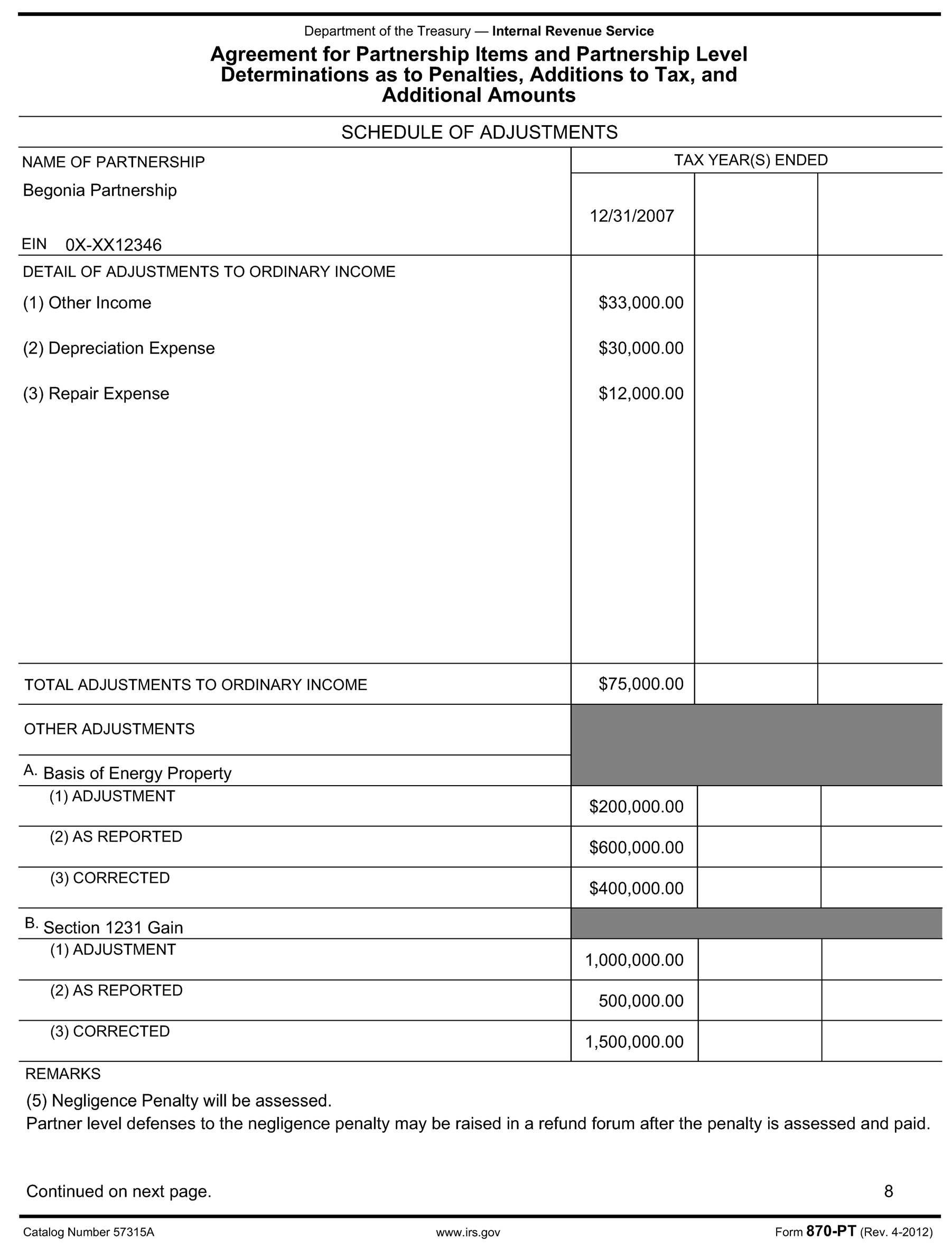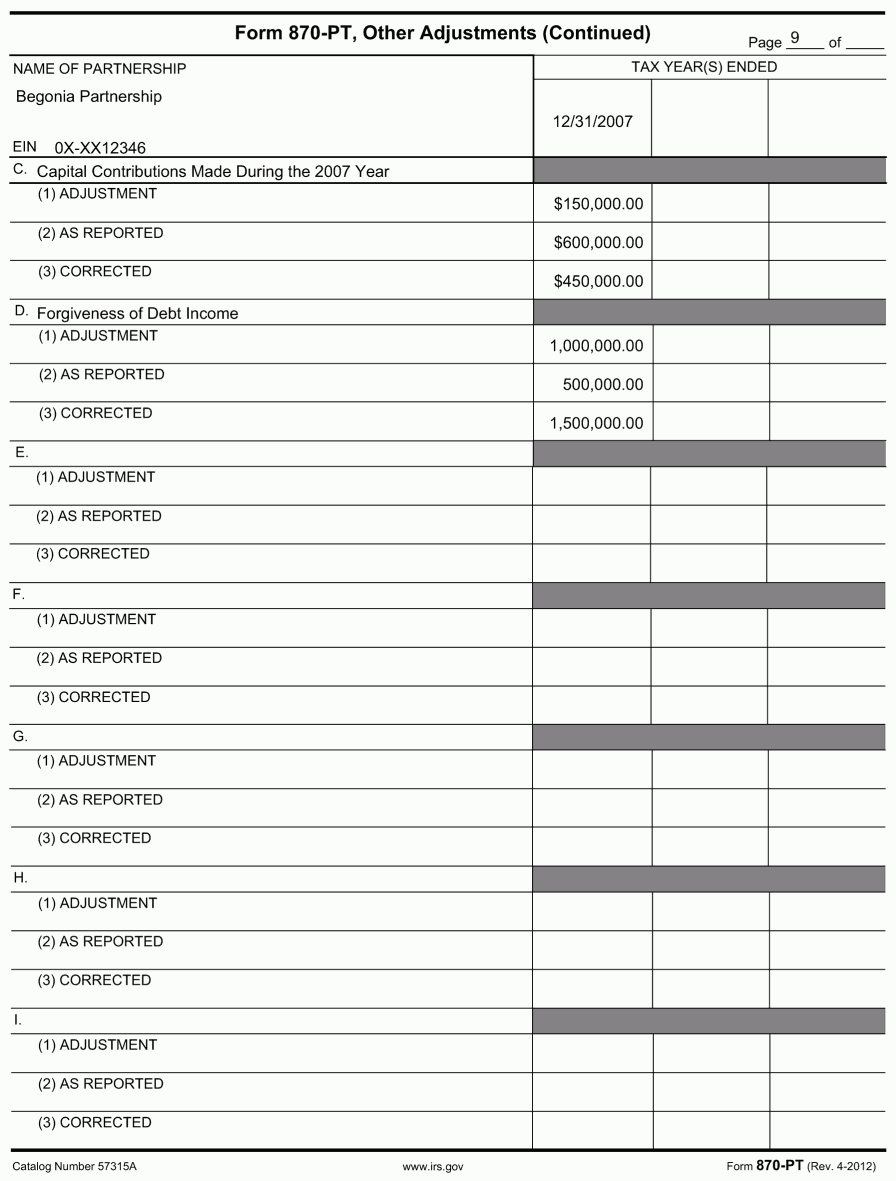- 8.19.12 Final Partnership Administrative Adjustment
- 8.19.12.1 Program Scope and Objectives
- 8.19.12.1.1 Background
- 8.19.12.1.2 Authority
- 8.19.12.1.3 Responsibilities
- 8.19.12.1.4 Program Reports
- 8.19.12.1.5 Terms and Acronyms
- 8.19.12.1.6 Related Resources
- 8.19.12.2 Final Partnership Administrative Adjustment
- 8.19.12.2.1 Appeals TEFRA Team (ATT)
- 8.19.12.2.2 Partnership Tax years Ending Before August 6, 1997
- 8.19.12.3 Notice of Final Partnership Administrative Adjustment (FPAA)
- 8.19.12.3.1 Joint Returns
- 8.19.12.3.2 Consolidated Returns
- 8.19.12.4 Request For Audit Work
- 8.19.12.5 Responsibilities of the Tax Computation Specialist (TCS)
- 8.19.12.5.1 Letter 1830 Addressed To The Generic TMP and The Named TMP
- 8.19.12.5.2 Schedule of Adjustments Page of Form 870–PT
- 8.19.12.5.3 Explanation of Adjustments
- 8.19.12.5.4 Form 4605–A (Examination Changes - Partnerships, Fiduciaries, S Corporations and Interest Charge Domestic International Sales Corporations)
- 8.19.12.5.5 Form 886–Z (TEFRA Partners’ Shares of Income)
- 8.19.12.5.6 Information Only Page
- 8.19.12.5.7 Entire FPAA for the Named TMP and the Generic TMP
- 8.19.12.6 Closing Package to the Campus TEFRA Function (CTF)
- 8.19.12.7 Campus TEFRA Function (CTF) Mails All FPAAs
- 8.19.12.7.1 Monitoring The FPAA
- 8.19.12.7.2 Updating ACDS Controls
- 8.19.12.8 Appeals Office Mails TMP FPAAs and CTF Mails Notice Partner FPAAs
- 8.19.12.8.1 Monitoring The FPAA
- 8.19.12.8.2 Updating ACDS Controls
- 8.19.12.9 Appeals Mails All FPAAs
- 8.19.12.9.1 Monitoring the FPAA
- 8.19.12.9.2 Updating ACDS Controls
- 8.19.12.10 Untimely Mailing of Notice
- 8.19.12.11 Judicial Review of an FPAA
- 8.19.12.11.1 Filing Actions
- 8.19.12.11.2 Priority of Actions
- 8.19.12.12 Defaulted Cases (No Petition Filed)
- 8.19.12.12.1 Preparing Administrative File and Closing Package for Default
- 8.19.12.12.2 Closing the Case after FPAA Defaults
- 8.19.12.13 Petitions to the Tax Court
- 8.19.12.13.1 Notifying the Campus TEFRA Function (CTF)
- 8.19.12.14 Petitions to the U.S. Court of Federal Claims or a U. S. District Court
- 8.19.12.14.1 Authorization to Send Administrative File
- 8.19.12.14.2 Preparing Administrative File and Closing Package
- 8.19.12.14.3 Closing the Case
- 8.19.12.14.4 Preparation of Key Case Administrative File
- Exhibit 8.19.12-1 FPAA Schedule of Adjustments Page of Form 870-PT
- Exhibit 8.19.12-2 Schedule of Adjustments Page of Form 870-PT--No Change
- Exhibit 8.19.12-3 FPAA Explanation of Adjustments--Partnership Tax Year Ending After August 5, 1997
- Exhibit 8.19.12-4 FPAA Explanation of Adjustments If All Partners Signed Partial Agreements
- Exhibit 8.19.12-5 FPAA Explanation of Adjustments If Some Partners Signed Partial Agreements
- Exhibit 8.19.12-6 FPAA Information Only Page--Partnership Tax Year Ending After August 5, 1997
- Exhibit 8.19.12-7 Form 3210 - Campus TEFRA Function to Mail All FPAAs
- Exhibit 8.19.12-8 Form 3210 - Campus TEFRA Function to Mail All FPAAs--No Change
- Exhibit 8.19.12-9 Form 3210 - Appeals Mailed FPAAs to TMP - Campus TEFRA Function to Mail FPAAs to Notice Partners
- Exhibit 8.19.12-10 Form 3210 - Appeals Mailed FPAAs to All Partners
- 8.19.12.1 Program Scope and Objectives
Part 8. Appeals
Chapter 19. Appeals Pass-Through Entity Handbook
Section 12. Final Partnership Administrative Adjustment
8.19.12 Final Partnership Administrative Adjustment
Manual Transmittal
May 13, 2025
Purpose
(1) This transmits revised IRM 8.19.12, Final Partnership Administrative Adjustment.
Material Changes
(1) Added new IRM section, Program Scope and Objectives, and its related subsections to comply with the Deputy Commissioner of Services and Enforcement and Operations Support memo, dated September 14, 2016, entitled Heightened Awareness, Sensitivity and Understanding of Internal Controls.
(2) Added Taxpayer Bill of Rights (TBOR) content based on guidance from the Division Counsel/Associate Chief Counsel (National Taxpayer Advocate Program) and Branch 3 of the Associate Chief Counsel (Procedure and Administration) to the Related Resources section of the Internal Controls.
(3) Added the following statement to the Related Resources section of the Internal Controls: “In accordance with IRM 25.30.2.3, Statement of Commitment, Appeals will work collaboratively with the Taxpayer Advocate Service (TAS) to enhance the taxpayer experience. For more information, see IRM 25.30.2, Service Level Agreement between the IRS Independent Office of Appeals and the Taxpayer Advocate Service.”
Effect on Other Documents
IRM 8.19.12 dated April 19, 2016 is superseded.Audience
All Independent Office of Appeals employees working with TEFRA partnership returns.Effective Date
(05-13-2025)John E. Hinding
Director, Specialized Examination Programs and Referrals
-
Purpose: This IRM section describes the statute processes and procedures for working TEFRA Key and Partner Cases in the IRS Independent Office of Appeals (Appeals).
-
Audience: Appeals Technical Employees and Appeals Team Managers that work TEFRA cases.
-
Policy Owner: Appeals Technical Guidance is under the Director, Specialized Examination Programs and Referrals
-
Program Owner: Appeals Technical Guidance is the program office responsible for providing technical and Procedural Guidance to Appeals employees for TEFRA issues.
-
Contact Information: Appeals employees should follow established procedures on How to Contact an Analyst. Other employees should contact the Product Content Owner shown on the Product Catalog Information Page for this IRM.
-
The Tax Equity and Fiscal Responsibility Act of 1982 (TEFRA) was enacted for partnership-level audit procedures under IRC Sections 6221 through 6234. Under the TEFRA unified proceeding, all administrative and judicial proceedings to determine the correct treatment of partnership items were conducted at the partnership level. TEFRA was in effect for 35 years, until its repeal and replacement by the Bipartisan Budget Act (BBA) of 2015 partnership audit regime which applies to all partnership returns beginning after December 31,2017.
-
TEFRA was codified under pre-2018 IRC Sections 6221 through 6234 and provides authority for this IRM.
-
Section 1101 of the Bipartisan Budget Act (BBA) of 2015 repealed TEFRA partnership and Electing Large Partnership (ELP) provisions for tax years beginning after December 31, 2017, and replaced it with a new centralized partnership audit regime. The new regime provides for determination, assessment and collection of underpayments at the partnership level unless certain elections are made by the partnership.
-
The author of this IRM is shown on the Product Catalog Page as the originator.
-
Policy, Planning, Quality, and Analysis (PPQA) provides trend and data analyses and detailed summary reports for Appeals.
-
See IRM 8.1.1-1, Common Terms Used in Appeals, for common terms and definitions used in IRM Part 8.
-
The Taxpayer Bill of Rights (TBOR) lists rights that already existed in the tax code, putting them in simple language and grouping them into 10 fundamental rights. Employees are responsible for being familiar with and acting in accord with taxpayer rights. See IRC 7803(a)(3), Execution of Duties in Accord with Taxpayer Rights. For additional information about the TBOR, see https://www.irs.gov/taxpayer-bill-of-rights.
-
In accordance with IRM 25.30.2.3, Statement of Commitment, Appeals will work collaboratively with the Taxpayer Advocate Service (TAS) to enhance the taxpayer experience. For more information, see IRM 25.30.2, Service Level Agreement between the IRS Independent Office of Appeals and the Taxpayer Advocate Service.
-
All guidance in this section of the IRM concerning the Campus TEFRA Functions (CTFs) is for cases controlled on the Partnership Control System (PCS). The CTFs only work with key cases and partners controlled by PCS. All references in this IRM to appeals officers (AO) applies equally to appeals team case leaders (ATCL) and any actions required by appeals team managers (ATM) are performed by appeals team case leaders as to their own cases.
-
Appeals employees must follow the work request procedures to request ATT assistance. Use of the ATT is mandatory for agreement package, closing package, and FPAA preparation. Follow the work request procedures in IRM 8.19.1.1.1, Appeals TEFRA Team (ATT). Also see detailed procedures for using the ATT on their ATT SharePoint site. A link to the site is found on the Appeals TEFRA website.
-
These procedures are written for partnership tax years ending after August 5, 1997. If you have a partnership whose tax year ends before August 6, 1997, please contact the TEFRA Technical Specialists or the TEFRA AO assigned to your case for guidance.
-
The Final Partnership Administrative Adjustment (FPAA) is similar to a statutory notice of deficiency except that it shows only the determined treatment of partnership items rather than a tax deficiency.
-
The IRS must mail an FPAA to the Tax Matters Partner (TMP) whether or not the TMP, as a partner, has agreed to the proposed adjustments. The mailing of the FPAA to the TMP suspends the statute of limitations on the partnership and establishes the time periods within which a petition may be filed by the TMP and any notice partner or 5 percent group.
-
The IRS must also mail an FPAA to every notice partner who does not agree to the settlement, including a spouse who does not agree.
-
See IRM 8.17.4.28, Notices of Deficiency, for when to send an FPAA to Associate Area Counsel for review.
-
For joint returns, a duplicate FPAA must be prepared and mailed to each spouse if both are unagreed.
-
Unique issues arise in the context of the TEFRA provisions when applied to persons who file a joint return. Generally, the signatures of both spouses, or an authorized representative for both, are needed on a settlement agreement. If only one spouse signs the settlement agreement (agreement form), the other spouse may or may not remain a party to the TEFRA proceeding. Either an FPAA or a notice of deficiency will have to be mailed to the spouse that did not sign the agreement. See Treas. Reg. 301.6231(a)(2)-1(a) and Treas. Reg. 301.6231(a)(12)-1(a).
-
If either spouse was also the TMP, then an FPAA must also be mailed to that spouse in his/her capacity as the TMP whether or not that spouse signed an agreement form.
-
For consolidated return tax years beginning before June 28, 2002, Treas. Reg. 1.1502-77A(a) provides that the common parent corporation in a consolidated group is the sole agent for the group. Thus, the FPAA should be mailed to the common parent corporation.
-
If the parent corporation or one of its subsidiaries was also the TMP, then an FPAA must also be mailed to that corporation in its capacity as the TMP whether or not an agreement form was signed.
-
See IRM 8.19.11.4.2 for guidelines for the signature block of the Form 870-PT that is mailed with the FPAA, depending on whether the parent corporation or the subsidiary corporation was the partner and if one was also the TMP.
-
-
For consolidated return tax years beginning on or after June 28, 2002, Treas. Reg. 1.1502-77(a)(6)(iii) provides that the Service will deal directly with any member in its capacity as a partner of a TEFRA partnership. However, Treas. Reg. 1.1502-77(a)(2)(ix) provides that an FPAA with respect to any partnership in which a member of the group is a partner may be mailed to the common parent. Thus, the FPAA should be mailed to the common parent corporation.
-
If the parent corporation or one of its subsidiaries was also the TMP, then an FPAA must also be mailed to that corporation in its capacity as the TMP whether or not an agreement form was signed.
-
See IRM 8.19.11.4.2 for guidelines for the signature block of the Form 870-PT that is mailed with the FPAA, depending on whether the parent corporation or the subsidiary corporation was the partner and if one was also the TMP.
-
-
The AO should request work from the TCS by preparing Form 3608 (Request for Tax Computation Specialist (TCS) Service).
-
For unagreed cases, there are three methods by which the FPAAs may be mailed to the partners:
-
The CTF mails the FPAAs to all partners, including those to the TMP.
-
Appeals mails the TMP FPAAs and the CTF mails the FPAAs to the notice partners.
-
Appeals mails the FPAAs to all partners, including those to the TMP.
Note:
The examiner is required to link a TEFRA partnership on PCS when the case is still in process 60 days after the case goes into status 12. IRM 8.19.10.4.4. If the case is not controlled on PCS, the CTF cannot be used to mail the FPAAs as the CTFs only work with cases that are controlled on PCS. All FPAAs would have to be mailed by Appeals.
-
-
The request for audit work should specify who will be mailing the FPAAs to the TMP and to the partners as the documents that are prepared by the TCS will be different depending on who is doing the mailing.
-
The preferred method is to have the CTF prepare and mail the FPAAs to all partners, including the TMP. The CTFs generate the FPAA letters and agreement forms using the PCS, which has current partner filing status and address information to ensure correct mailing. Appeals should generally be mailing FPAAs only when there is a short statute or there are a small number of partners.
-
If Appeals will be mailing the FPAAs to the notice partners, the FPAA letters and agreement forms will have to be prepared by Appeals and the request for audit work should specify whether the TCS should prepare them. For more information, refer to “Appeals Mails All FPAAs” in IRM 8.19.12.9 below.
-
The request for audit work should also:
-
Advise if there are any penalties or affected items.
-
Advise the TCS if any partial agreements were secured from any of the partners as this will need to be noted in the Schedule of Adjustments page and the Explanation of Adjustments in the FPAA.
-
Provide any name or address changes for the TMP or any address changes for the partnership; also, if there is no longer a named TMP, this should be noted.
-
Provide the language for the explanatory paragraphs if the language from one of the sample paragraphs located on the TCS website for Notices of Deficiency will not be used; the AO is responsible for reviewing and revising these paragraphs, as necessary.
-
If the TCS is expected to prepare the explanatory paragraphs, then the AO must provide the ACM. See IRM 8.17.4.2.
-
-
The TCS will prepare the following documents whether the CTF or Appeals mails the FPAAs to the partners.
-
Two Letters 1830 (Final Partnership Administrative Adjustment) - one addressed to the generic TMP and one addressed to the named TMP
-
The Schedule of Adjustments page of Form 870-PT
-
Explanation of Adjustments
-
Form 4605–A
-
Form 886–Z
-
An "Information Only" page, if applicable
-
-
The TCS will also begin preparing the closing package to the CTF (including the Form 3210). See IRM 8.19.12.6.
-
Depending upon local procedures, the TCS will compute the revised dollar value for the key case using IRM Exhibit 8.19.10-1 .
-
If Appeals will be mailing the FPAAs to the notice partners, the TCS may be asked to prepare them. For more information, refer to “Appeals Mails All FPAAs” in IRM 8.19.12.9 below.
-
If there is a valid Power of Attorney on file for a notice partner, a copy of the FPAA will be prepared for the representative only if the Power of Attorney includes the language in IRM 8.19.6.5.
-
-
The Letter 1830 for the generic TMP:
-
Should be addressed generically to: "The Tax Matters Partner" of the TEFRA partnership.
-
The Letter 1830 will include the address as shown on the partnership return. If the address of the partnership was updated in accordance with Treas. Reg. 301.6223(c)-1, a second Letter 1830 should be prepared for that address. A Letter 1830 should also be prepared for any other address if it is known that the address of the partnership has changed.
-
On page one of the Letter 1830, the taxpayer identification number (TIN) field should either be left blank or include the TIN of the partnership.
-
-
The Letter 1830 for the named TMP:
-
Should be addressed to the TMP by name.
-
The Letter 1830 will include the address shown on the Schedule K-1. If the last known address of the TMP has changed based on researching Master File, a second Letter 1830 should be prepared for that address. A Letter 1830 should also be prepared for any other address if it is known that the address of the named TMP has changed.
-
On page one of the Letter 1830, the TIN field should be the TIN of the TMP, the TIN of the partnership, or be left blank.
-
-
Only one tax year should be included on the Letter 1830.
-
The Schedule of Adjustments page is the part of the agreement form that shows the partnership adjustments.
-
For partnership tax years ending after August 5, 1997, use Form 870–PT. Only one tax year should be included on each Schedule of Adjustments page unless the partners have not changed.
-
The allocation of all partners must be shown on the Schedule of Adjustments page if the correct allocation of partnership items or partners' ownership is an issue. See IRM 8.19.10.4.8.4. See also IRM Exhibit 8.19.11-3 (allocation of partnership items) and IRM Exhibit 8.19.11-4 (allocation of partners' ownership).
-
The Schedule of Adjustments page will include all adjustments even if some issues were settled by partial agreements for some or all of the partners. For additional information on partial agreements see IRM 8.19.11.11.
-
For partnership tax years ending after August 5, 1997, as penalties are determined at the partnership level, any penalties should be included on the Schedule of Adjustments page of Form 870-PT. Include a comment in the remarks section of the Schedule of Adjustments page that partner level defenses can be raised in a refund proceeding after the penalties have been assessed and paid.
-
See Exhibit 8.19.12-1 for a sample Schedule of Adjustments page for a Form 870-PT.
-
For a no-change case, the Schedule of Adjustments page will show no adjustments. See Exhibit 8.19.12-2 for a sample Schedule of Adjustments page of a Form 870-PT for a no-change FPAA. See IRM 8.19.10.4.9 and IRM 8.19.11.13 for more information on no-change cases.
-
Unless otherwise instructed by the AO, the TCS will use the sample paragraphs located on the Appeals TCS website for Notices of Deficiency as guides for the explanatory paragraphs in the FPAA. If the TCS prepares the paragraphs, then the AO should give the ACM to the TCS to assist them in choosing or writing an appropriate paragraph.
-
For partnership tax years ending after August 5, 1997, as penalties are determined at the partnership level, any penalties should be included in the Explanation of Adjustments.
-
See Exhibit 8.19.12-3 for a sample Explanation of Adjustments for a partnership tax year ending after August 5, 1997.
-
When partial agreements were obtained by the AO, the TCS will include appropriate language explaining this in the FPAA. See Exhibit 8.19.12-4 for an example where all partners agreed to a partial settlement and Exhibit 8.19.12-5 for an example when only some partners agreed to a partial settlement. For additional information on partial agreements see IRM 8.19.11.11.
-
An Explanation of Adjustments is not needed for a no-change case.
-
The Form 4605–A is not part of the FPAA. However, it is prepared to show both the adjustments and corrected income/loss of the partnership.
-
The TCS should work from the return and take into account any Form 8082 (AAR) and Form 1065X that were processed, if applicable. The only issues that should be shown on the Form 4605–A are the ones that result in an adjustment to the amount shown on the return.
Note:
The CTFs will treat all issues not shown on the Form 4605-A as issues accepted as filed on the Form 1065. A notation on the Form 4605-A in the remarks section should be made to notify the CTF that all issues which are not shown on the Form 886–Z are accepted as shown on the Form 1065 and Schedules K-1.
-
The TCS will prepare a new Form 4605-A only if the one in the administrative file is incorrect or has been modified by Appeals.
-
The following information should be shown at the top or in the remarks section of Form 4605-A:
-
"FPAA"
-
"Information Only—Do Not Mail to Taxpayer"
-
-
Include an IRC 6404(g) key case comment on the Form 4605-A in the remarks section. See IRM 8.19.1.7 and IRM 8.17.6.9. For example, if the earliest notice that was issued was a 60-day letter that was dated March 15, 2006, enter "60-day letter" and "March 15, 2006." There may be more than one notice for the same return and more than one IRC 6404(g) notice date.
-
See IRM Exhibit 8.19.11-1 for a sample Form 4605-A. Although this exhibit is from IRM 8.19.11 on Agreed Cases, the format is the same. However, instead of "Appeals Settlement," "FPAA" should be inserted.
-
Form 4605-A is not needed for a no-change case.
-
The Form 886–Z is not part of the FPAA. However, it is necessary in order to show the partners' corrected partnership items and penalty or affected item adjustments.
-
A separate Form 886-Z should be prepared for each tax year.
-
Partners' addresses are required on the Form 886-Z only when Appeals is mailing the FPAAs to the notice partners.
-
If Appeals is mailing the FPAAs to the notice partners, the TCS should request current IDRS information to verify the partner addresses and to determine if a joint return was filed by the partner.
-
-
If there are non-notice partners, they should be listed together on a Form 886-Z separate from the Form 886-Z that lists notice partners.
-
The Form 886-Z should only show the issues that changed from the Schedules K-1. It is unnecessary to show no-change issues. The CTFs will treat all issues not shown on the Form 886-Z as correctly shown on the Schedule K-1.
-
The following should be clearly marked on the top or in the center of Form 886-Z:
-
"FPAA"
-
"Information Only – Do Not Mail to Taxpayer"
-
-
The partner information on the Form 886-Z should be listed either alphabetically or in TIN order.
-
Reconcile any notice and non-notice Form 886-Z to make certain that the total for column (3) equals 100%. The amounts shown on these forms, along with the items shown on the Schedule K-1 that have not changed, will be used by the CTFs to make the partners' recalculations.
-
The TSUMYP and case file should be reviewed to distinguish between partners who have agreed (who will not receive an FPAA) and those who will receive an FPAA. Although the percentage of profits will equal 100%, the ordinary income (loss) shown on the Form 886-Z may not reconcile to the corrected distributable income on Form 4605–A due to the difference between base amounts of agreed and unagreed partners.
-
Where penalties or affected items are at issue, columns (8) through (12) should be used to list the separate penalties and affected items.
-
For partnership tax years ending after August 5, 1997, see IRM Exhibit 8.19.11-2. In this exhibit, there is a 20% negligence penalty and an at-risk affected item.
-
-
Form 886-Z is not needed for a no-change case.
-
Refer to IRM 8.19.10.4.3.1 for additional information about this form.
-
An "Information Only" page (which is not a numbered page of the FPAA) is needed in the FPAA for partnership tax years ending after August 5, 1997, if there are affected items other than penalties.
-
For partnership tax years ending after August 5, 1997, the applicability of penalties, additions to tax and additional amounts are determined at the partnership level and are directly assessed following the partnership proceedings. However, affected items will not be a part of the FPAA (in either the Schedule of Adjustments page or in the Explanation of Adjustments). The FPAA must, however, contain a determination of the underlying issues that affect the affected items at the partner level.
-
The "Information Only" page will be included in the FPAA mailing stating that affected items other than penalties may be raised after the TEFRA proceedings are concluded.
-
See Exhibit 8.19.12-6 for a sample "Information Only" page for a partnership tax year ending after August 5, 1997.
-
-
The FPAA for both the named TMP and the generic TMP will include the following documents:
-
Letter 1830 (see instructions above)
-
Entire agreement form (Form 870–PT)
-
Explanation of Adjustments (see instructions above)
-
"Information Only" page, if applicable (see instructions above)
Note:
An FPAA should be prepared for the named TMP in his capacity as the named TMP even if he has agreed to the settlement or otherwise had his partnership items converted to nonpartnership items. However, if it is known that there is no longer a named TMP (for example, the named TMP is deceased and the partnership has not designated a new TMP), then an FPAA does not have to be prepared for the named TMP.
-
-
The agreement form for each TMP FPAA consists of the signature page of the Form 870PT, the instructions for signing, and the Schedule of Adjustments page.
-
On the Form 870-PT that is included with the generic TMP FPAA, the TIN field should either be left blank or include the TIN of the partnership. Also, the "Name of Tax Matters Partner" field should be left blank.
-
On the Form 870-PT that is included with the named TMP FPAA, the TIN field should be the TIN of the TMP, the TIN of the partnership, or be left blank. The "Name of Tax Matters Partner" field should include the name of the TMP.
-
-
Each page of the FPAA (including the agreement form, instructions for signing, and the Schedule of Adjustments page) should clearly state the page number. However, the "Information Only" page (if applicable) is not a numbered page.
-
If there is a valid Power of Attorney on file for the named TMP, prepare an FPAA for the representative if the Power of Attorney includes the language in IRM 8.19.6.5.
-
If there is a valid Power of Attorney on file for the partnership, prepare a generic TMP FPAA for the partnership representative.
-
A TEFRA closing package is a group of documents that is prepared and assembled after a TEFRA key case is resolved. The closing package is mailed to the key case CTF to associate with the tax returns of the partners in the TEFRA partnership in order that the tax resulting from their share of the adjustments made to the TEFRA partnership return are computed and assessed in a timely manner.
-
The TCS will begin preparing the closing package to the CTF (including the Form 3210).
-
If at the time that the TCS begins preparing the closing package and the Form 3210, some of the documents have not as yet been prepared by the AO (for example, the ACM or Form 5402), the AO will complete the preparation of the closing package.
-
The AO is responsible for reviewing the closing package and is ultimately responsible for the accuracy and completeness of the documents.
-
If the CTF will be mailing all FPAAs (including those to the TMP), refer to Exhibit 8.19.12-7 for a sample Form 3210 that lists the documents needed in the closing package.
-
If the CTF will be mailing all FPAAs (including those to the TMP) for a no-change case, refer to Exhibit 8.19.12-8 for a sample Form 3210 that lists the documents needed in the closing package.
-
If Appeals will be mailing the TMP FPAAs and the CTF will be mailing the FPAAs to the notice partners, refer to Exhibit 8.19.12-9 for a sample Form 3210 that lists the documents needed in the closing package.
-
If Appeals will be mailing the FPAAs to all partners (including those to the TMP), refer to Exhibit 8.19.12-10 for a sample Form 3210 that lists the documents needed in the closing package.
-
-
An IRC 6404(g) key case comment should be included on the Form 3210 in the "Necessary Actions" section. See IRM 8.19.1.7 and IRM 8.17.6.9. For example, if the earliest notice that was issued was a 60-day letter that was dated March 15, 2006, enter "60-day letter" and "March 15, 2006." There may be more than one notice for the same return and more than one IRC 6404(g) notice date.
-
The AO, secretary, clerk, or APS (as determined locally) will make photocopies of the documents to be included in the completed closing package.
-
In all situations, the AO is responsible for:
-
the accuracy and completeness of the Form 3210,
-
reviewing the completed closing package, and
-
submitting it to APS to mail to the key case CTF.
-
-
APS is responsible for:
-
ensuring all documents listed on the Form 3210 are attached,
-
sending the completed package to the CTF by controlled mail, and
-
monitoring the return of the acknowledged Form 3210.
-
-
There must be at least 45 days remaining on the partnership statute in order for the CTF to mail the FPAAs.
-
If the CTF will be mailing all FPAAs, the TCS would have prepared:
-
An entire FPAA for the both the generic TMP and the named TMP. Each page of the FPAA (including the agreement form, instructions for signing, and the Schedule of Adjustments page) should clearly state the page number. However, the "Information Only" page (if applicable) is not a numbered page
-
The Schedule of Adjustments page of Form 870–PT
-
Explanation of Adjustments
-
Form 4605–A
-
Form 886–Z
-
An "Information Only" page, if applicable
-
-
After reviewing the documents prepared by the TCS (including the FPAA package and Form 3210), the AO will prepare a Form 5402 and submit the case and the FPAA package to the ATM for approval before the FPAA package is mailed to the CTF.
-
The AO will ensure that all documents listed on the Form 3210 are included in the FPAA package. The AO is ultimately responsible for the accuracy and completeness of the Form 3210.
-
The AO should ensure that any special instructions for the key case CTF are included on the Form 3210.
-
While waiting for the CTF to mail the FPAAs to the partners, the AO should update the ACDS status code to “E/TEF” (Inactive, waiting for TEFRA action outside office).
-
After the TMP FPAAs are approved and signed by the ATM, the administrative file (including the TMP FPAAs) and the FPAA package will be given to local APS.
-
Local APS enters the following in the ACDS fields:
-
ACTION: Area location - LGN (example: Ship AUS-LGN)
-
TODATE: Date local APS ships the administrative file to Laguna Niguel APS
-
Local APS ships the administrative file with the FPAA package to Laguna Niguel APS
-
ACDS database for AO and AIMS remain open (not closed or transferred)
-
-
Laguna Niguel APS, upon receipt of the administrative file and FPAA package, enters the following in the ACDS fields:
-
FROM DATE: Date received in Laguna Niguel APS
-
-
Laguna Niguel APS will mail the FPAA package, including the signed "undated" TMP FPAAs (and any prepared for Powers of Attorney), to the key case CTF by controlled mail using the Form 3210 prepared by the TCS or AO. APS will ensure that the documents listed on the Form 3210 are included in the FPAA package. Instructions for monitoring the return of the Form 3210 by APS may be found in IRM 8.19.12.6.
-
The key case CTF will:
-
Date and mail the FPAAs to the TMP
-
Prepare, date, and mail FPAAs to the notice partners generally on the same day but no later than 60 days thereafter; these will be generated by PCS to the Schedule K-1 address and to the last known address on Master File
-
Return copies of the dated TMP FPAAs and the Certified Mailing List to Appeals for the administrative file
-
-
APS will take the following steps to monitor the FPAA.
-
Maintain a copy of the FPAA package and Form 3210 in the administrative file.
-
Place the administrative file in suspense until Appeals receives verification that the CTF issued the FPAAs to the TMP.
-
-
The Docketed Information Management System (DIMS) is used to monitor the FPAA as well as statutory notices of deficiency. DIMS is a subsystem of ACDS, as described in IRM 8.20.3.1.
-
When APS receives verification (acknowledged Form 3210, copies of the TMP FPAAs, and copy of the Certified Mailing List) from the key case CTF that the FPAAs have been mailed to the TMP, APS will take the following actions:
-
On ACDS, update the SNTYPE field with "FPAA."
-
On ACDS, update the SNDATE field using the date that the FPAAs were mailed to the TMP from the Certified Mailing List. The SN Expires date will be computer generated.
-
Update SN issued to "Y" on return level of ACDS.
-
Place copies of the acknowledged Form 3210, the TMP FPAAs, and the Certified Mailing List in the administrative file.
-
Return the administrative file to suspense.
-
-
If Appeals will be mailing the FPAAs to the TMP and the CTF will be mailing the FPAAs to the notice partners, the TCS would have prepared:
-
An entire FPAA for the both the generic TMP and the named TMP. Each page of the FPAA (including the agreement form, instructions for signing, and the Schedule of Adjustments page) should clearly state the page number and total number of pages in the notice, e.g. Page 1 of 4. However, the "Information Only" page (if applicable) is not a numbered page.
-
The Schedule of Adjustments page of Form 870–PT
-
Explanation of Adjustments
-
Form 4605–A
-
Form 886–Z
-
An "Information Only" page, if applicable
-
-
After reviewing the documents prepared by the TCS (including the closing package and Form 3210), the AO will prepare a Form 5402 and submit the case and the FPAA package to the ATM for approval before the TMP FPAAs are mailed by Laguna Niguel APS and the FPAA package is mailed to the CTF.
-
The AO will ensure that all documents listed on the Form 3210 are included in the FPAA package. The AO is ultimately responsible for the accuracy and completeness of the Form 3210.
-
The AO should ensure that any special instructions for the key case CTF are included on the Form 3210.
-
After the TMP FPAAs are approved and signed by the ATM, the administrative file, the TMP FPAAs, and the FPAA package will be given to local APS.
-
Local APS enters the following in the ACDS fields:
-
ACTION: Area location-LGN (example: Ship AUS-LGN)
-
TODATE: Date local APS ships the administrative file to Laguna Niguel APS
-
Local APS ships the administrative file with the FPAA package to Laguna Niguel APS
-
ACDS database for AO and AIMS remain open (not closed or transferred)
-
-
Laguna Niguel APS, upon receipt of the administrative file and FPAA package, enters the following in the ACDS fields
-
FROM DATE: Date received in Laguna Niguel APS
-
-
Laguna Niguel APS will date and send by certified mail all original TMP FPAAs included in the FPAA package. Copies will be mailed to Powers of Attorney as noted below, but not by certified mail:
-
If there is a valid Power of Attorney on file for the named TMP, a copy of the named TMP FPAA will be mailed to the representative only if the Power of Attorney includes the language in IRM 8.19.6.5.
-
-
Within 5 working days after Laguna Niguel APS mails the FPAAs to the TMP, Laguna Niguel APS will mail the FPAA package, including three dated copies of each FPAA mailed to the TMP (and any mailed to Powers of Attorney), and a copy of the Certified Mailing List, to the key case CTF by controlled mail using the Form 3210 prepared by the TCS or AO.
-
The key case CTF has 60 days from the date the FPAA was mailed to the TMP to mail the FPAAs to the partners so it is critical that APS sends the FPAA package to the key case CTF within 5 working days of issuing the FPAAs to the TMP.
-
APS will ensure that the documents listed on the Form 3210 are included in the FPAA package. Instructions for monitoring the return of the Form 3210 by APS may be found in IRM 8.19.12.6.
-
-
The key case CTF will prepare, date, and mail FPAAs to the notice partners no later than 60 days after the FPAAs were mailed to the TMP. These will generally be mailed on the same day but no later than 60 days thereafter, and will be generated by PCS to the Schedule K-1 address and to the last known address on Master File.
-
APS will take the following steps to monitor the FPAA.
-
Maintain a copy of the FPAA package and Form 3210 in the administrative file.
-
Place copies of the TMP FPAAs (including any issued to Powers of Attorney) and the Certified Mailing List in the administrative file.
-
Place the administrative file in suspense.
-
-
The Docketed Information Management System (DIMS) is used to monitor the FPAA as well as statutory notices of deficiency. DIMS is a subsystem of ACDS, as described in IRM 8.20.
-
After APS issues the FPAAs to the TMP, APS will take the following actions:
-
On ACDS, update the SNTYPE field with "FPAA."
-
On ACDS, update the SNDATE field using the date that the FPAAs were mailed to the TMP from the Certified Mailing List. The SN Expires date will be computer generated.
-
Update SN issued to "Y" on return level on ACDS.
-
-
When APS receives the acknowledged Form 3210 from the CTF, place a copy in the administrative file.
-
When Appeals will be mailing the FPAAs to the notice partners, the AO may request that the TCS prepare an entire FPAA for the notice partners in addition to those for the TMP.
-
In this situation, dialogue will be required between the ATM of both the AO and the TCS as to specifically what the TCS will prepare and the Form 3608 should specify that Appeals will be mailing the FPAAs to the notice partners.
-
The AO should identify any special circumstances on the Form 3608, including parent-subsidiary relationships. The AO is ultimately responsible for the accuracy and completeness of the FPAAs.
-
-
If Appeals will be mailing all FPAAs, the TCS would have prepared:
-
An entire FPAA for the both the generic TMP and the named TMP. Each page of the FPAA (including the agreement form, instructions for signing, and the Schedule of Adjustments page) should clearly state the page number. However, the "Information Only" page (if applicable) is not a numbered page.
-
An entire FPAA for each notice partner, including Letter 1830 (unless these were prepared by the AO). The Letter 1830 will include the address shown on the Schedule K-1. If the last known address of the partner has changed based on researching Master File, a second Letter 1830 should be prepared for that address. A Letter 1830 should also be prepared for any other address if it is known that the address of the partner has changed.
Note:
If the named TMP has not agreed to the settlement or otherwise had his partnership items converted to nonpartnership items, the named TMP will be issued an FPAA in his capacity as a notice partner in addition to his capacity as the named TMP.
-
The Schedule of Adjustments page of Form 870–PT
-
Explanation of Adjustments
-
Form 4605–A
-
Form 886–Z
-
An "Information Only" page, if applicable
-
-
After reviewing the documents prepared by the TCS (including the FPAA package and Form 3210), the AO will prepare a Form 5402 and submit the case and the FPAA package to the ATM for approval before the FPAAs are mailed to the TMP and to the notice partners and the FPAA package is mailed to the CTF.
-
The AO will ensure that all documents listed on the Form 3210 are included in the FPAA package. The AO is ultimately responsible for the accuracy and completeness of the Form 3210.
-
After the FPAAs are approved and signed by the ATM, the administrative file, the FPAAs, and the FPAA package will be given to local APS.
-
Local APS enters the following in the ACDS fields:
-
ACTION: Area location-LGN (example: Ship AUS-LGN)
-
TODATE: Date local APS ships the administrative file to Laguna Niguel APS
-
Local APS ships the administrative file with the FPAA package to Laguna Niguel APS
-
ACDS database for AO and AIMS remain open (not closed or transferred)
-
-
Laguna Niguel APS, upon receipt of the administrative file and FPAA package, enters the following in the ACDS fields:
-
FROM DATE: Date received in Laguna Niguel APS
-
-
Laguna Niguel APS will date and send by certified mail all original TMP and notice partner FPAAs. The FPAAs to the notice partners should generally be dated and mailed on the same day as when the FPAAs are mailed to the TMP, but no later than 60 days thereafter in order to avoid an untimely notice issue (see IRM 8.19.12.10). Copies will be mailed to Powers of Attorney as noted below, but not by certified mail:
-
If there is a valid Power of Attorney on file for the named TMP or any of the notice partners, a copy of the FPAA will be mailed to the representative only if the Power of Attorney includes the language in IRM 8.19.6.5.
-
-
Within 5 working days after Laguna Niguel APS mails the FPAAs to the partners, Laguna Niguel APS will mail the FPAA package to the key case CTF by controlled mail using the Form 3210 prepared by the TCS. The FPAA package will include:
-
Three dated copies of each FPAA mailed to the TMP
-
One copy of each FPAA mailed to the notice partners
-
One copy of any FPAA mailed to Powers of Attorney
-
A copy of the Certified Mailing List
-
-
Laguna Niguel APS will ensure that the documents listed on the Form 3210 are included in the FPAA package. Instructions for monitoring the return of the Form 3210 by APS may be found in IRM 8.19.12.6.
-
APS will take the following steps to monitor the FPAA.
-
Maintain a copy of the FPAA package and Form 3210 in the administrative file.
-
Place copies of the TMP and notice partner FPAAs (including any issued to Powers of Attorney) and the Certified Mailing List in the administrative file.
-
Place the file in suspense.
-
-
The Docketed Information Management System (DIMS) is used to monitor the FPAA as well as statutory notices of deficiency. DIMS is a subsystem of ACDS, as described in IRM 8.20.3.1.
-
After Laguna Niguel APS issues the FPAAs to the TMP, take the following actions:
-
On ACDS, update the SNTYPE field with "FPAA."
-
On ACDS, update the SNDATE field using the date that the FPAAs were mailed to the TMP from the Certified Mailing List. The SN Expires date will be computer generated.
-
Update SN issued to "Y" on return level on ACDS.
-
-
When APS receives the acknowledged Form 3210 from the CTF, place a copy in the administrative file.
-
The IRS is required to mail the Notice of Beginning of Administrative Proceeding (NBAP) to the notice partners 120 days before IRS mails an FPAA to the TMP. See IRC 6223(d)(1). The Exam Form 886–Z shows the partners to whom an NBAP was mailed and the certified mailing date.
-
The IRS is also required to mail an FPAA to a notice partner within 60 days of the mailing of the FPAA to the TMP. See IRC 6223(d)(2).
-
If the IRS does not mail these notices to a partner within these time frames, the partners not receiving timely notices have certain rights depending on whether the partnership proceeding is still going on or it has been completed.
-
Proceeding still going on: If, at the date of mailing an FPAA, the notice requirements of IRC 6223(d) will not be met, a Letter 3857 must be mailed to those partners who will receive untimely notices. Letter 3857 will advise those partners of their right to elect out of the partnership proceeding. Refer to IRM 8.19.1.6.7.2. The AO is responsible for preparing Letter 3857. The FPAA and the Letter 3857 will have the same date and will be mailed in the same envelope by APS or the key case CTF.
-
Proceeding finished: If IRS does not send a required notice until after the proceeding is finished, a partner receiving the late notice is removed from the TEFRA proceeding unless the partner elects to be bound by the proceeding, or requests an earlier offered settlement (IRC 6223(e)). If the partner does not elect to have the adjustment, court decision, or settlement apply, the partnership items of the partner for the partnership tax year are treated as nonpartnership items. Refer to IRM 8.19.1.6.7.2. The AO is responsible for preparing Letter 3858. The FPAA and the Letter 3858 will have the same date and will be mailed in the same envelope by APS or the key case CTF.
-
-
This subsection explains the procedure for judicial review of an FPAA.
-
IRC 6226 establishes rules for the judicial review of an FPAA. The time for filing a petition for readjustment (petition) is different for the TMP than for the other partners.
-
The TMP has the exclusive right to file a petition with the Tax Court, the U. S. District Court for the district where the partnership's principal place of business is located, or the U.S. Court of Federal Claims within 90 days from the date the IRS mailed the FPAA to the TMP. No other partner may file an action within this 90-day period.
-
If the TMP does not file a petition, any notice partner or 5-percent group may file a petition with any of the courts within 60 days after the expiration of the 90 day period.
-
The TMP may file a petition during the first 90 days in the capacity as TMP or during the remaining 60 day period as a notice partner (Barbados #6 Ltd. v. Commissioner, 85 T.C. 900 (1985)). If a 5-percent group is formed to file a petition, all members of the group must join in filing the petition.
-
If a notice partner or 5-percent group files a petition within 90 days from the date IRS mailed the FPAA to the TMP, but the TMP and no other partners file a petition, the premature petition is deemed filed on the last day of the 60 day period (IRC 6226(b)).
-
The TMP has first priority to select the court where the petition will be filed. The TMP must file the petition in the capacity as TMP during the 90 day period described above.
-
If the TMP does not file during the 90 day period, any notice partner or 5-percent group may file a petition during the following 60 day period. If more than one petition is filed during the 60 days, the first petition filed in the Tax Court will control and all other petitions will be dismissed. If no petition is filed in Tax Court, the first petition in any other court will go forward and the remaining petitions will be dismissed.
-
For purposes of determining which U. S. District Court will have jurisdiction, the partnership’s principal place of business will be the location on the date the petition is filed.
Example:
The TMP files a petition with a U. S. District Court during the 90 day period. Partner A files a petition to the Tax Court. Partner A’s petition will be dismissed and the action in the U. S. District Court will go forward.
Example:
The TMP does not file a petition during the 90 day period. Partner A files a petition in a U. S. District Court on the 92nd day. Partner B files a petition to the Tax Court on the 140th day. The petition to the U. S. District Court will be dismissed even though it was filed earlier. Any petition to the Tax Court by a notice partner will have priority over notice partner or 5-percent group petitions to the other two courts.
-
APS will monitor the docket lists referred to in IRM 8.19.12.7.1, IRM 8.19.12.8.1, and IRM 8.19.12.9.1. If a petition has not been identified within 180 days, APS will default the case following procedures in this subsection.
-
Notification of a default may also come from the key case CTF if they issued the FPAA to the TMP.
-
APS will electronically transmit the default closing package to the key case CTF by 195 days after the FPAA is mailed to the TMP, unless the FPAA is petitioned.
-
APS prepares the Form 14298 to electronically transmit the default closing package to the CTF. The documents required for the default closing package (the FPAA package) are saved on the shared server used for electronic transmission.
Caution:
The ATT should ensure that any instructions to the key case CTF for issuing affected-item reports or affected-item notices of deficiency are included on the Form 14298 used to transmit the FPAA package. APS should ensure the instructions are on the Form 14298 used to transmit the default closing package.
-
APS will enter the one-year statute date on ACDS. In computing the one-year statute date, one day should be subtracted from the date that the FPAA defaulted.
-
APS will electronically transmit the default closing package to the key case CTF.
-
It is not necessary to prepare a new Form 5402. The Form 5402 that was previously prepared is sufficient to close the case.
-
All TEFRA key cases must be closed by Laguna Niguel APS.
-
After Laguna Niguel APS has received an acknowledged Form 3210 from the CTF and the CTF has input a one-year statute date on PCS for all direct partners, APS closes the case from ACDS as follows:
-
Closing code 05 and date closed
-
ACTION--ACKCLS & TODATE
-
RevsdTax--Enter revised tax from Form 5402 (also enter PropdTax if not previously entered); if the Form 5402 does not contain the revised tax, have the ATT compute the amount using IRM Exhibit 8.19.10-1
-
See IRM 8.20.7 for instructions in completing Form 5403; in addition, enter "TEFRA Key Case Closing" in the Special Handling section
-
-
After the key case CTF has input the one-year statute date on PCS for all direct partners and has released the AIMS "H" freeze, Laguna Niguel APS may close the case from AIMS unless it has a PICF code of 4 or 5. The case should not be sent to the key case CTF unless it has a PICF Code of 4 or 5.
-
If the case has a PICF Code of 4 or 5, it is a partner in another TEFRA partnership and has to be sent to the key case CTF. Instructions for identifying the key case CTF may be found on the Appeals TEFRA website. Instructions for sending the case to the key case CTF are as follows:
-
Prepare Form 5403 following partial procedures. In item A, Special Handling Instructions, write "TEFRA Linkage – After Partial Closing, Forward to CTF."
-
Update the AIMS database to status 34. Update the PBC to 295 (for the Brookhaven CTF) or 398 (for the Ogden CTF).
-
Forward the administrative file via Form 3210, to the appropriate CTF. Ensure that a copy of the input Form 5403 is attached to the face of the return. The CTF will place the file in suspense awaiting the outcome of the TEFRA examination.
-
-
Laguna Niguel APS ensures that copies of the following documents are in the administrative file before it is closed:
-
Appeals Form 4605–A
-
Appeals Form 886–Z
-
Appeals Case Memorandum
-
Affected item Appeals Case Memorandum (if applicable)
-
Form 5402
-
All agreement forms or closing agreements for partners who agreed
-
Form 5403 (original)
-
Partnership statute extensions
-
-
A petition may be filed with the Tax Court, U.S. Court of Federal Claims or a U. S. District Court. The procedures discussed here apply to cases petitioned to the Tax Court only. If a petition is filed with either the U.S. Court of Federal Claims or a U. S. District Court, see IRM 8.19.12.14.
-
When the petition is received from Associate Area Counsel, APS will retrieve the key case administrative file, check the petition for accuracy, update ACDS as described below and forward the case file to Associate Area Counsel for answer.
-
If only one petition is filed, APS will update ACDS with the following case level information:
-
Docket number
-
Counsel office
-
Attorney
-
Closing code 43
-
Date Closed for trial preparation to Associate Area Counsel
-
Enter ACTION code DCJUR
-
TODATE is the date the case is forwarded to Associate Area Counsel
-
-
In addition, update ACDS with the following return level information:
-
Remove statute date from STATDATE field
-
Enter statute code: DOCKT
-
-
If multiple petitions have been filed, see IRM 8.19.10.2.3.1.
-
APS will update AIMS using CC:AMSTUB to Status "82."
-
In accordance with local procedures, APS will notify the AO and ATM that the case has been petitioned.
-
Refer to IRM 8.19.13 for procedures to follow if the case is later returned to Appeals to settle and when the case is closed by either Appeals or by Associate Area Counsel.
-
Notify the key case CTF that the TEFRA key case is docketed.
-
Instruct the CTF to mark the key case administrative file to show the docket number and to insert a statement that no agreement forms should be executed without contacting the AO first.
-
Instruct the CTF to add the docket number to the PCS database.
-
The key case CTF should be notified with this information using secure email.
-
A petition may be filed with either the U.S. Court of Federal Claims or a U.S. District Court and gain direct access to that court. Appeals will not acquire jurisdiction of a case for which a petition is filed in one of these courts. If an Appeals Office issues an FPAA and an action is filed with one of these courts, the Appeals Office will transfer the case file to Associate Area Counsel for processing to the Department of Justice using the procedures in this subsection.
-
If either of these courts is used, the partner who files the petition must make a deposit equal to the amount their tax liability would be increased if the adjustment in the FPAA were fully sustained.
-
The amount deposited is treated as a tax payment only for the purpose of computing interest.
-
If jurisdiction to the court is dismissed because of the priority of a Tax Court action, the partner may request a refund of the deposit.
-
If members of a 5-percent group file a petition, each partner must make the required deposit.
-
The deposit must be made on or before the date the petition is filed.
-
The deposit requirement is satisfied if there is a good faith attempt to deposit the correct amount and any shortfall is timely paid.
-
The deposit amount need only include the tax. Interest and penalties do not need to be deposited.
-
-
Even though the petitioning partner is the only partner that is required to make the deposit, the Service will assess and collect the tax deficiency against all partners who have an interest in the proceeding, including penalties and interest. The deposit may be applied to the assessment of the petitioning partner. No assessment may be made prior to the close of the 150th day after the day the FPAA was mailed to the TMP.
-
A U.S. Court of Federal Claims or U.S. District Court complaint will normally be sent to the local Associate Area Counsel office where the complaint is filed for preparation of the defense letter.
-
Upon receipt of the petition or complaint, it is the attorney's responsibility to:
-
Request the key case administrative file and the petitioner's return (if filed by a partner other than the TMP), following the method of authorization described in IRM 8.19.12.14.1.
-
Verify that the petitioner has made the required deposit.
-
Verify that no superseding Tax Court petition was timely filed. To be timely, a petition must be filed within 150 days from the date the FPAA was mailed to the TMP.
-
Verify the timeliness of the petition filed in the U.S. Court of Federal Claims or a U.S. District Court. To be timely, a petition must be filed within the 150-day period after the FPAA was mailed to the TMP.
-
Prepare the defense letter.
-
-
Petitions to the U.S. Court of Federal Claims or a U.S. District Court may be listed on the Electronic Docket List (EDL).
-
If there is no listing on the EDL, a copy of the first page of the petition will be accepted by APS as authorization to close these cases from ACDS.
-
If a valid petition is filed with one of these courts, APS will give the file to the ATT. The ATT AO will prepare a closing package to be sent to the key case CTF in order that the partners may be assessed whether or not the deposit was paid. The ATT AO will electronically send the closing package to the CTF using Form 14298, Appeals TEFRA Electronic Notice Package Check Sheet, as the cover sheet. The ATT AO is responsible for the accuracy and completeness of the Form 14298, including the one-year statute date.
-
Filing a petition with the U.S. Court of Federal Claims or with a U.S. District Court does not trigger the one-year statute date. However, for control purposes the ATT AO will enter a one-year statute date on the Form 14298 instructing the CTF to enter a one-year statute date on PCS.
-
The ATT AO will return the case to APS to suspense until the "H" freeze is released.
-
The FPAA package previously sent to the CTF includes all the information the CTF needs which may have included Letters 1830, Schedule of Adjustments, Explanation of Adjustments, Form 4605-A, Form 886-Z and the Information Only page. Additionally, a copy of the electronic docket list (EDL) or first page of the petition or complaint should be transmitted to the CTF.
-
It is not necessary to prepare a new Form 5402. The Form 5402 that was previously prepared is sufficient to close the case.
-
After the "H" freeze is released, APS will forward the administrative file to Associate Area Counsel via Form 2828, Transmittal Memorandum. Associate Area Counsel will forward the file to the Department of Justice. APS may then close the case from ACDS as follows:.
-
ACTION--ACKCLS
-
Statute Code—DOCKT
-
For cases petitioned to the U.S. Court of Federal Claims, input Docket Number 99999-99C and Closing Code 18.
-
For cases petitioned to a U. S. District Court, input Docket Number 99999-99D and Closing Code 19.
-
Closing date--enter date closed off ACDS.
-
Notes: enter "Department of Justice--Petitioned U.S. Court of Federal Claims or U. S. District Court," whichever is applicable
-
Action – ACKCLS
-
To Date-- Date closed.
-
Statute Date--remove any date
-
RevsdTax--Enter revised tax from Form 5402 (also enter PropdTax if not previously entered); if the Form 5402 does not contain the revised tax, have the AO compute the amount using IRM Exhibit 8.19.10-1
-
See IRM 8.20.7 for instructions in completing Form 5403; in addition, enter "TEFRA Key Case Closing" in the Special Handling section
-
-
After the key case CTF has input the one-year statute date on PCS for all direct partners and has released the AIMS "H" freeze, APS may close the case from AIMS unless it has a PICF Code of 4 or 5.
-
If the case has a PICF Code of 4 or 5, it is a partner in another TEFRA partnership and must be updated on AIMS to the key case CTF (even though the file is sent to Associate Area Counsel). Instructions for identifying the key case CTF may be found on the Appeals TEFRA website. Instructions for updating the case to the key case CTF are as follows:
-
Prepare Form 5403 following partial procedures. In item A, Special Handling Instructions, write "TEFRA Linkage – After Closing, Forward to CTF" .
-
Update the AIMS database to status 34. Update the PBC to 295 (for the Brookhaven CTF) or 398 (for the Ogden CTF).
-
-
Refer to IRM 8.19.13.3 for procedures to follow when the case is resolved by the Department of Justice and is returned to Appeals through Associate Area Counsel.
-
Ensure that the following documents are prepared and are in the file before closing the case:
-
Form 14298
-
Form 5403
-
Form 5402
-
Appeals Form 4605-A
-
Appeals Form 886-Z
-
Appeals Case Memorandum (ACM)
-
Form 2828 (Transmittal Memorandum)
-
Copies of all FPAAs that were issued
-
Copy of EDL or first page of petition/complaint
-
Form 2275
-
Affected item Appeals Case Memorandum (if applicable)
-
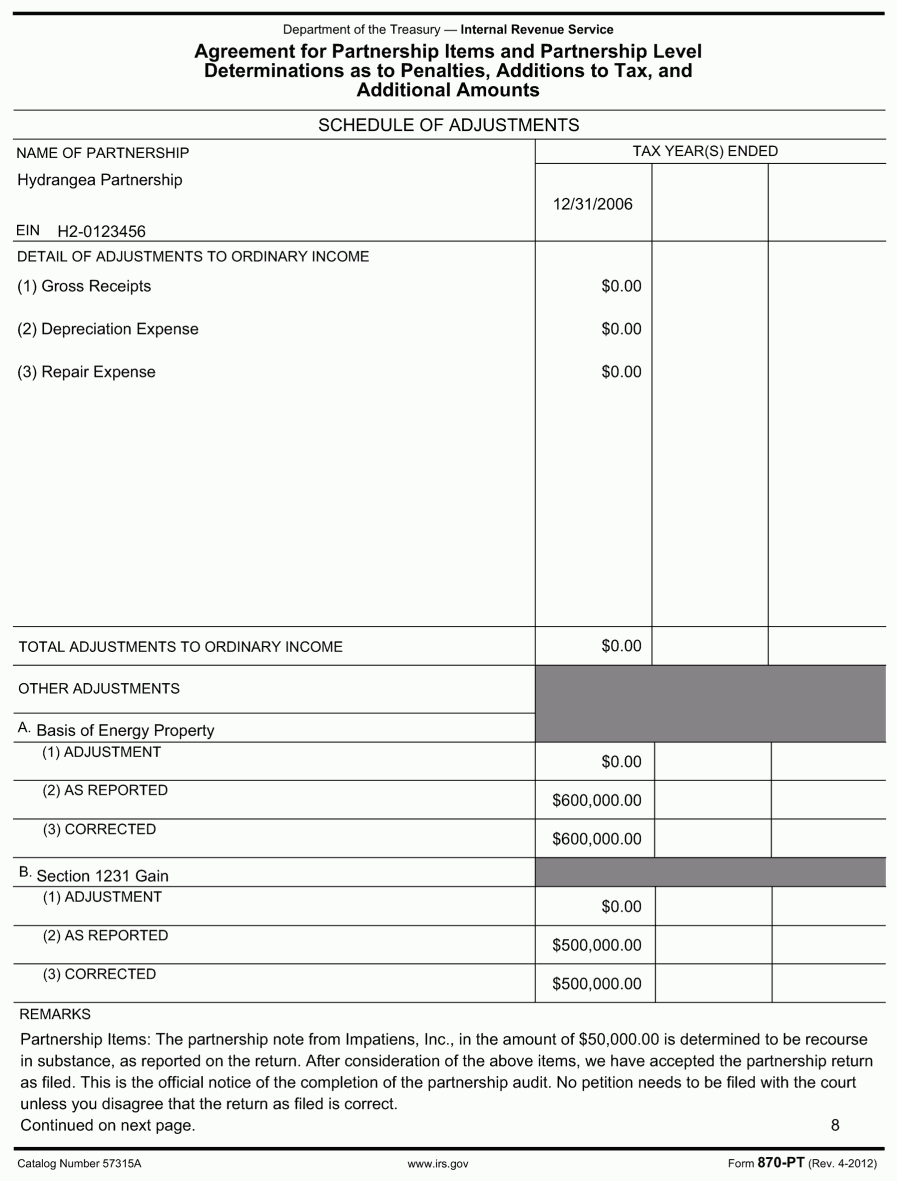
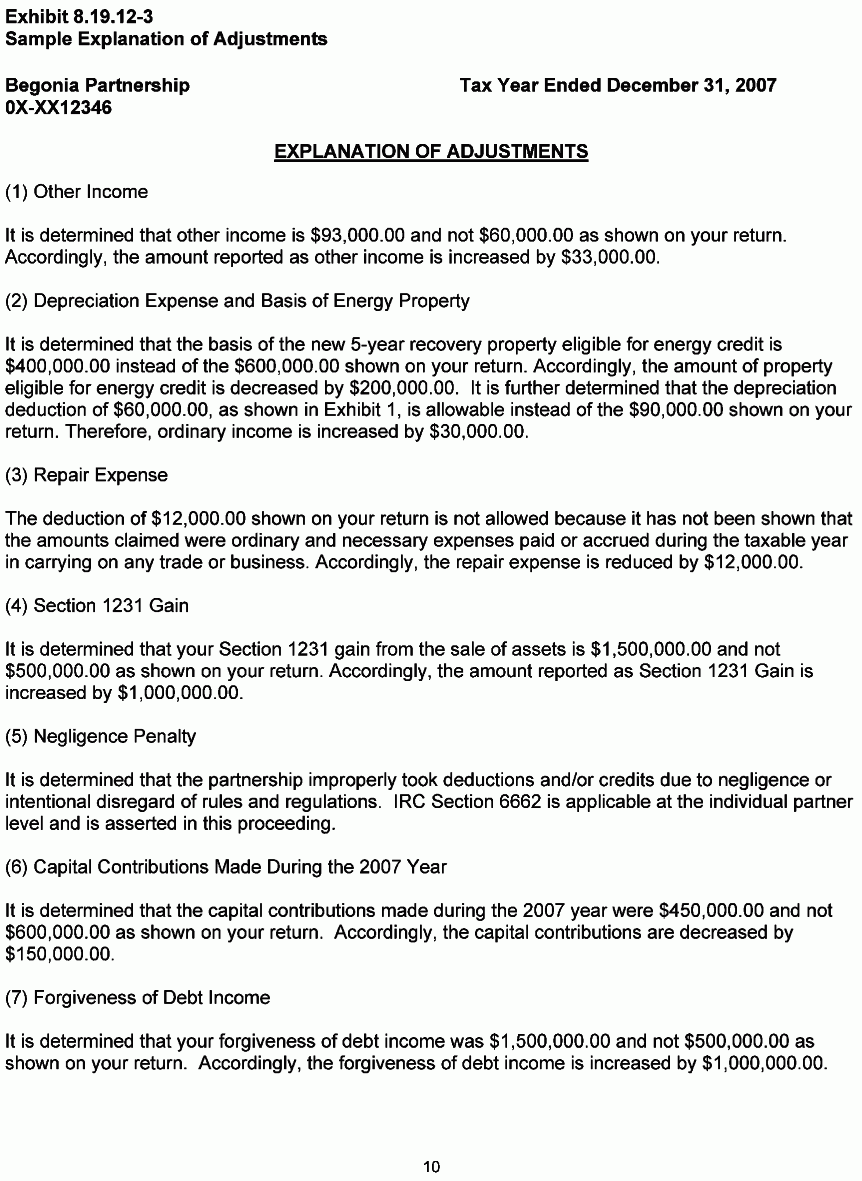
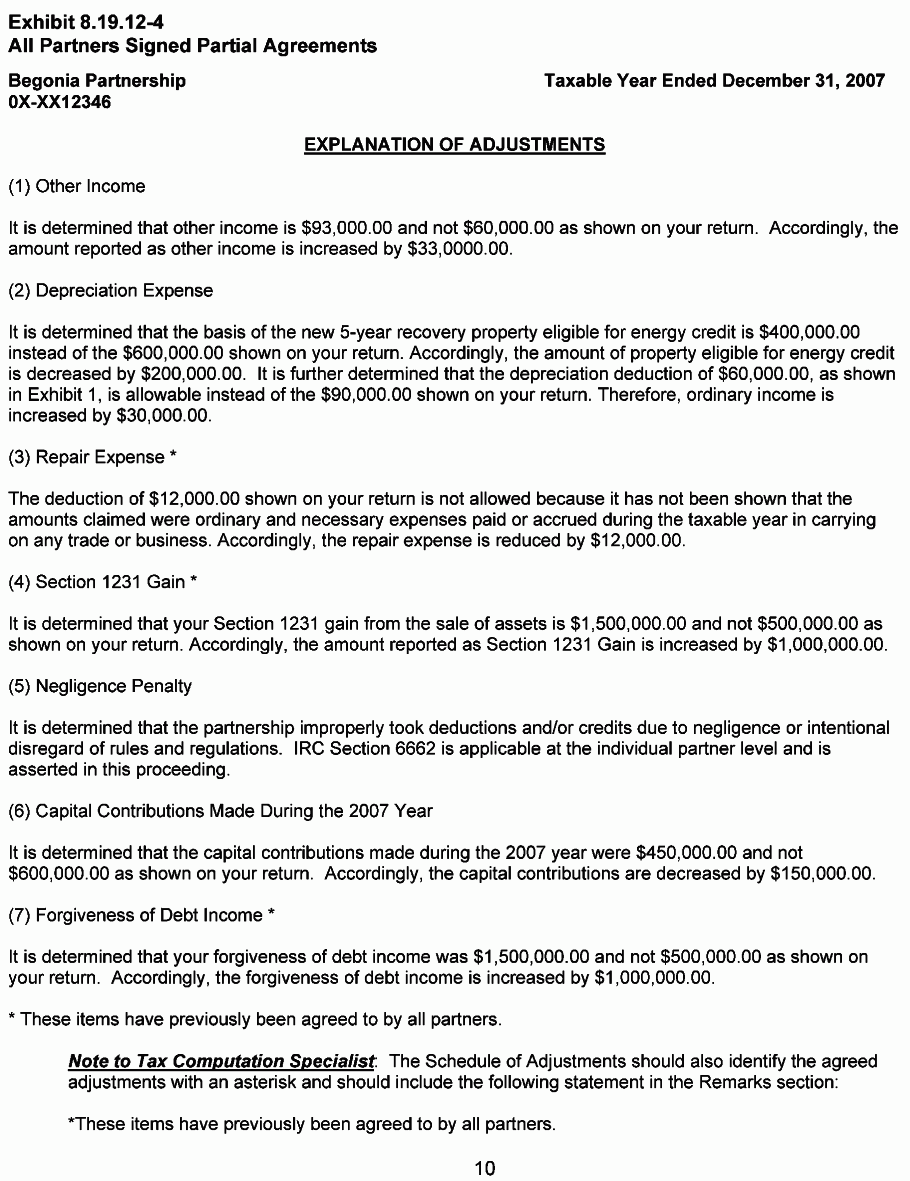
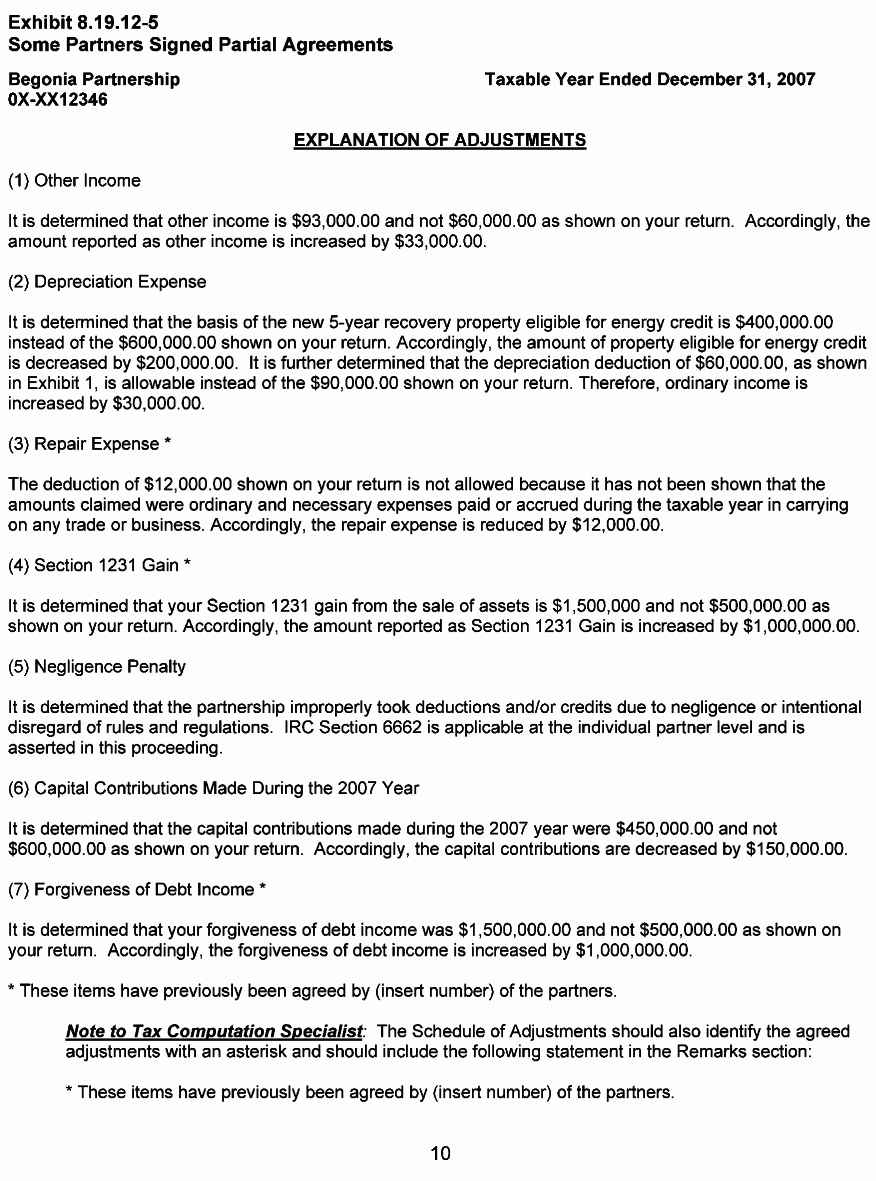
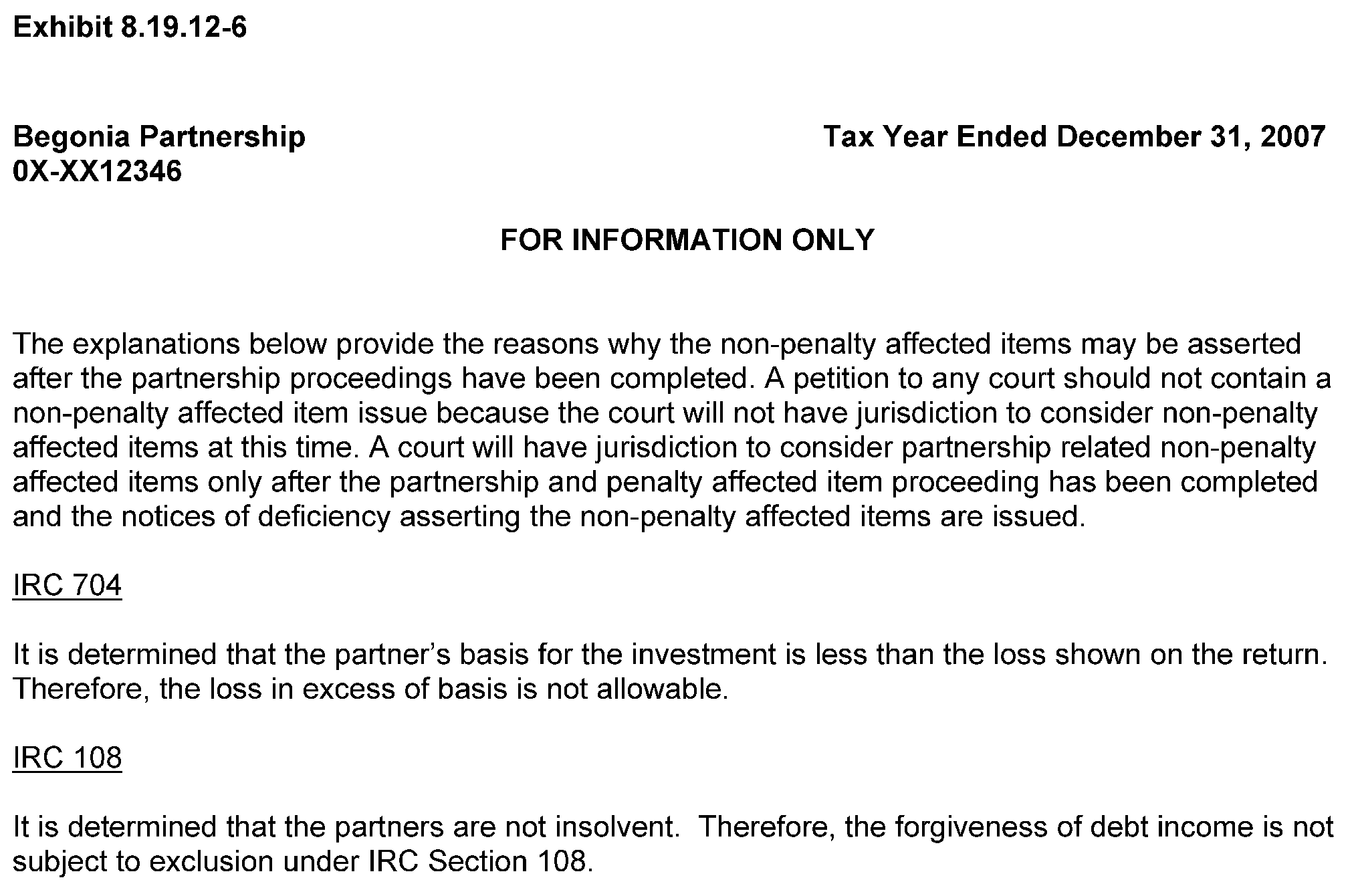
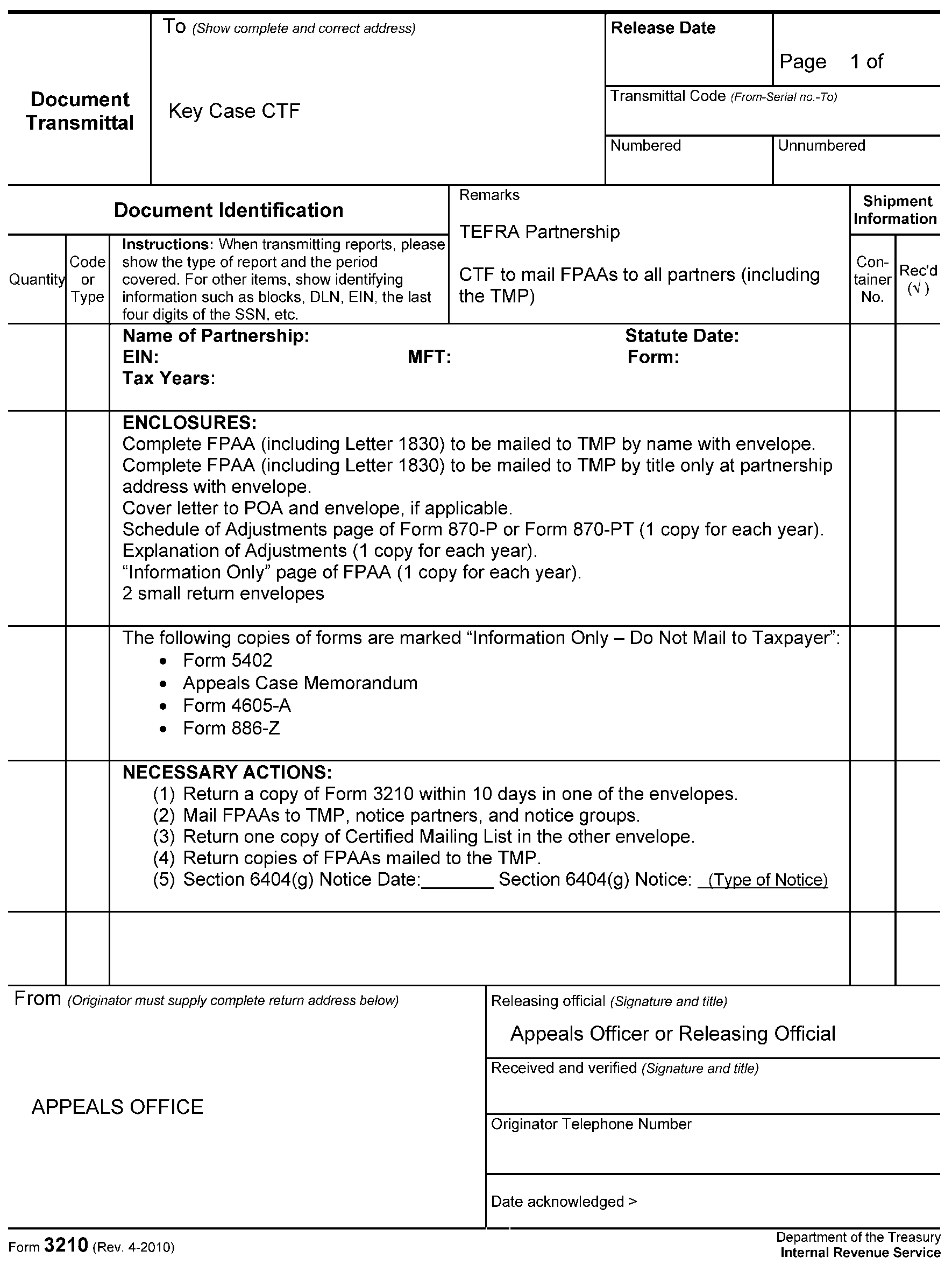
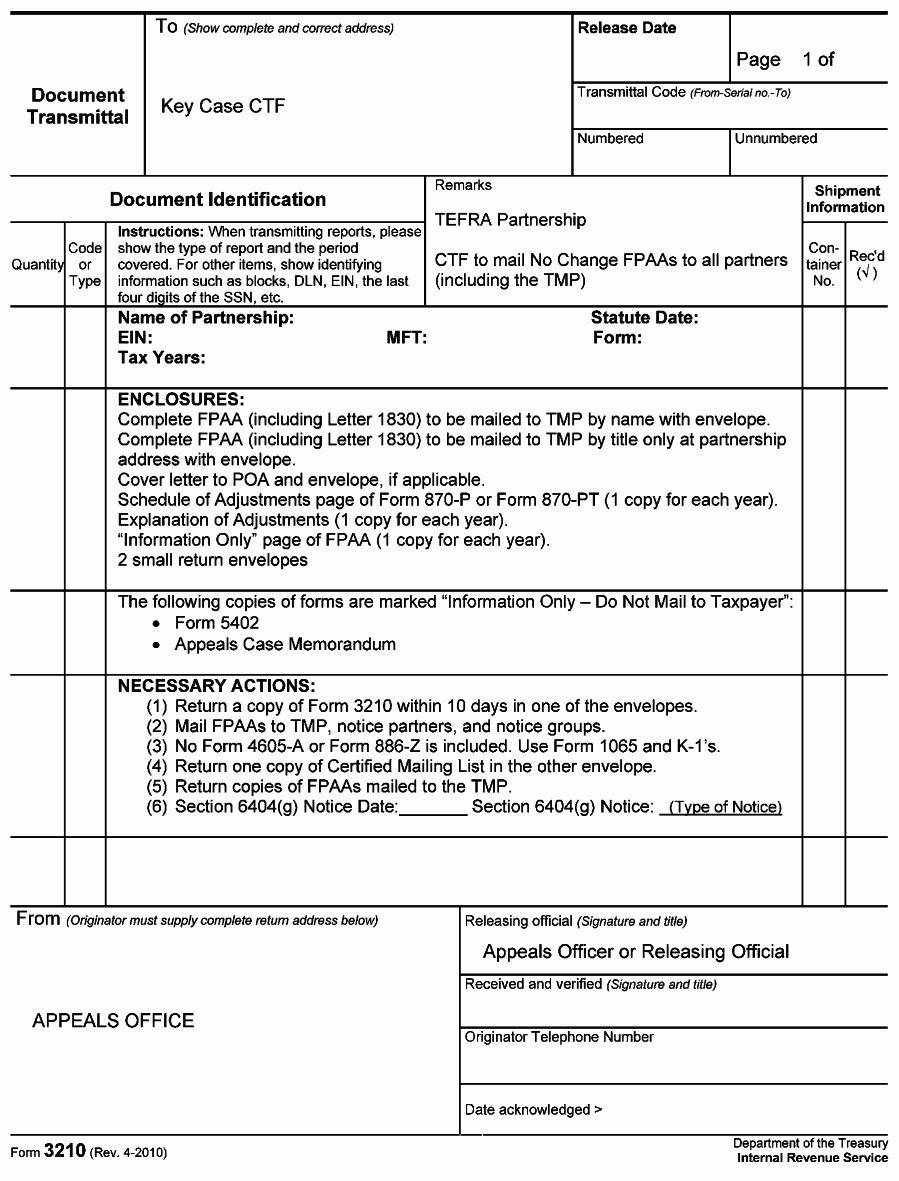
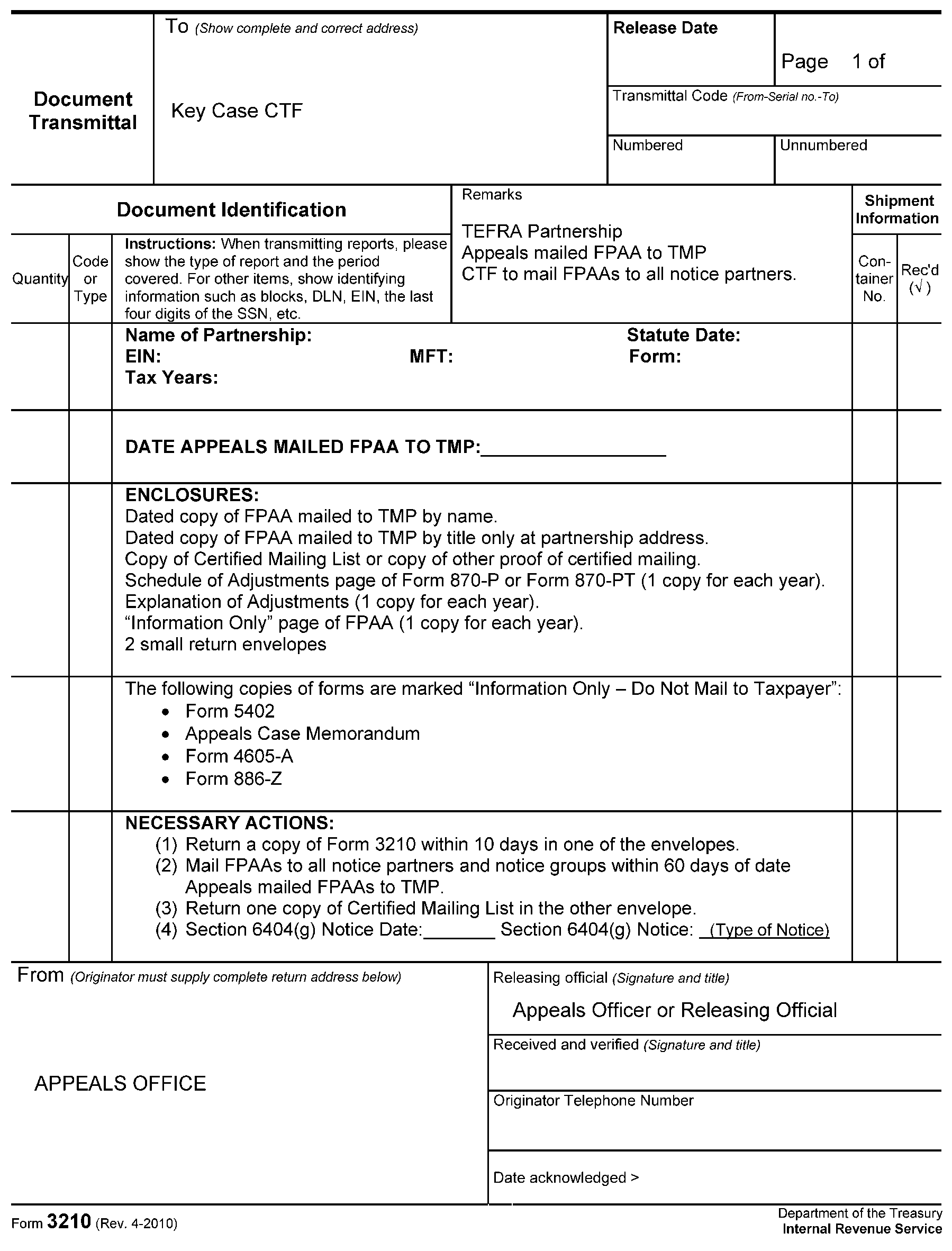
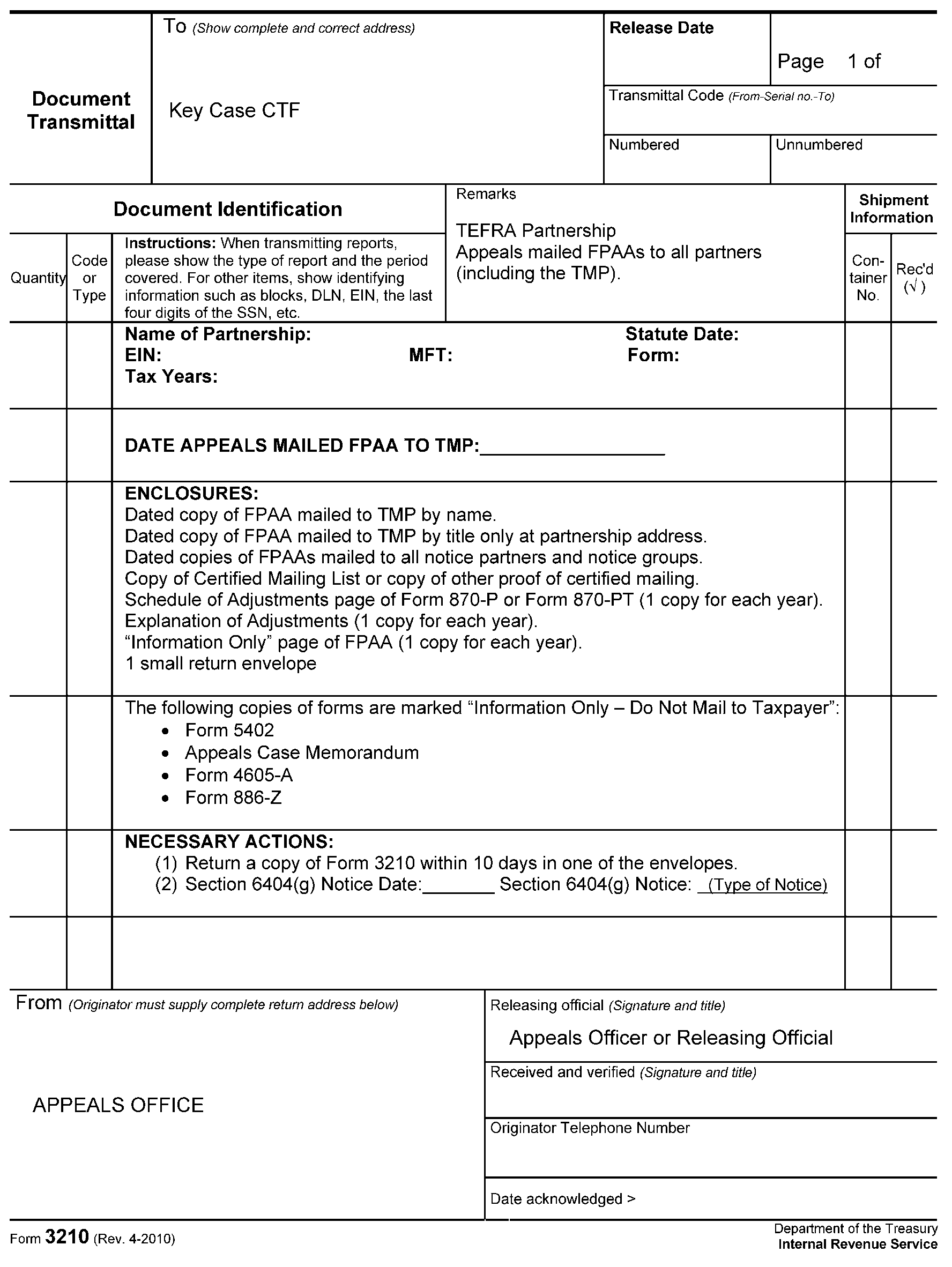

 )
o https:// significa que usted se conectó de forma segura a un sitio web .gov. Comparta información sensible sólo en sitios web oficiales y seguros.
)
o https:// significa que usted se conectó de forma segura a un sitio web .gov. Comparta información sensible sólo en sitios web oficiales y seguros.

